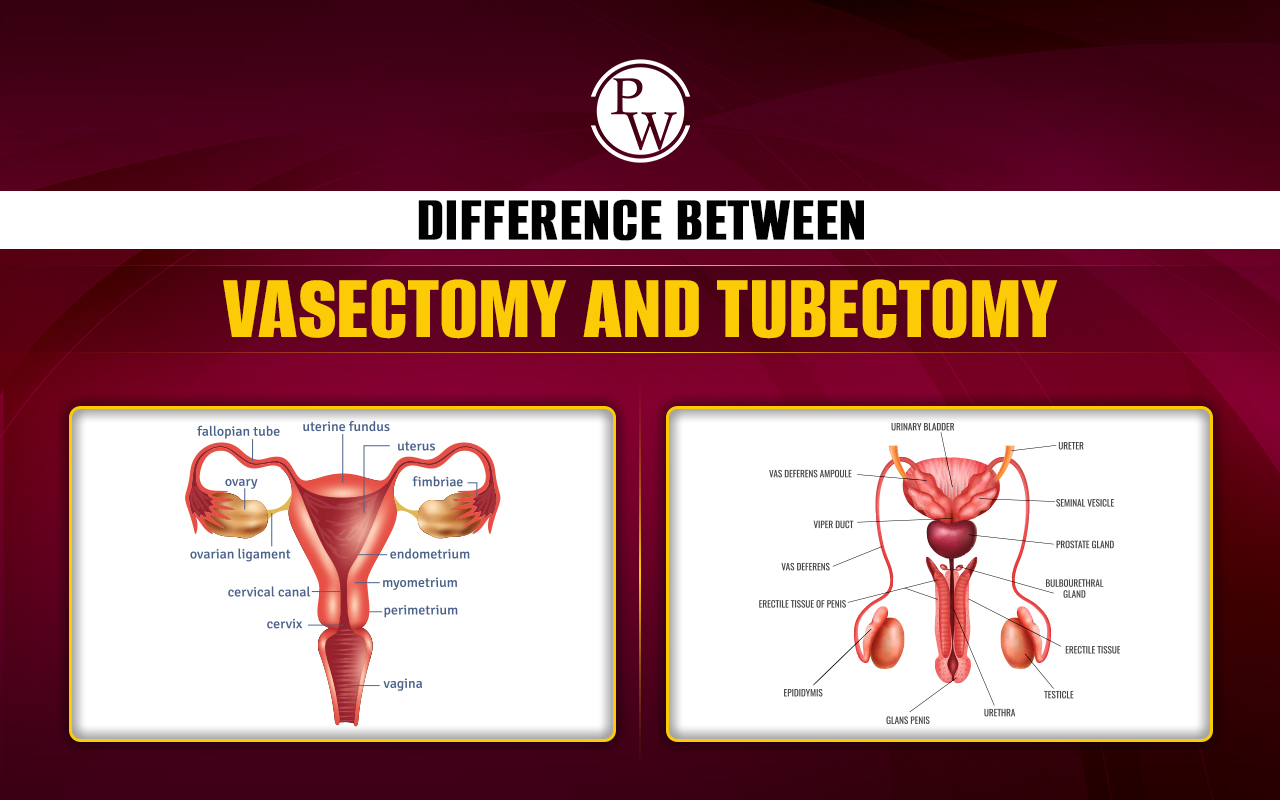

Difference Between Vasectomy and Tubectomy: The difference between vasectomy and tubectomy is an important topic in the reproductive health chapter in NEET Syllabus . A vasectomy is a permanent birth control method for men. It involves cutting or sealing the vas deferens, which stops sperm from mixing with semen. The procedure is quick, and recovery time is usually short.
| NEET Biology Syllabus | NEET Biology Diagrams |
| NEET Biology MCQ | NEET Biology Chapter wise Weightage |
| NEET Biology Notes | NEET Previous Year Question papers |
Tubectomy, also known as tubal ligation, is for women. It involves blocking or cutting the fallopian tubes, which prevents eggs from getting to the uterus. This procedure is more complicated, takes longer to recover from, and has a higher chance of complications. The article below provides NEET Notes on the difference between vasectomy and tubectomy for NEET students preparing for the upcoming exam.
What is Vasectomy and Tubectomy?
A vasectomy is a surgery that permanently prevents men from having children. It involves cutting and sealing the vas deferens, the tubes that carry sperm from the testicles. This stops sperm from mixing with semen during ejaculation, making it very effective at preventing pregnancy.
A tubectomy is a similar surgery for women. It involves cutting or blocking the fallopian tubes, which are the pathways that eggs travel from the ovaries to the uterus. This stops sperm from reaching the egg, preventing fertilization. Tubectomy is also considered a permanent form of birth control.
Difference Between Vasectomy and Tubectomy
Reproductive health chapter in the Class 12 curriculum is important, particularly for NEET chapter wise weightage , as it carries significant marks in the NEET exam . Students studying the difference between vasectomy and tubectomy can refer to the table below for a clear comparison.:
| Difference Between Vasectomy and Tubectomy | ||
| Aspect | Vasectomy | Tubectomy |
| Definition | Surgical procedure for male sterilization by cutting or sealing the vas deferens. | Surgical procedure for female sterilization by cutting or sealing the fallopian tubes. |
| Procedure |
|
|
| Anesthesia | Local anesthesia. | General or regional anesthesia. |
| Duration | Approximately 15-30 minutes. | Approximately 30-60 minutes. |
| Recovery Time | 1-2 days for initial recovery; full recovery in about a week. | 1-2 weeks for initial recovery; full recovery in about a month. |
| Effectiveness | Over 99% effective in preventing pregnancy. | Over 99% effective in preventing pregnancy. |
| Reversibility | Possible but difficult; success rates vary. | Possible but more complex and less likely to be successful. |
| Risks and Complications |
|
|
| Impact on Hormones | No impact on hormone levels. | No impact on hormone levels. |
| Impact on Sexual Function | No impact on sexual function. | No impact on sexual function. |
| Cost | Generally lower than tubectomy. | Generally higher than vasectomy. |
Characteristics of Vasectomy and Tubectomy
The following are the main features of vasectomy and tubectomy:
Characteristics of Vasectomy
Vasectomy effectively prevents pregnancy in men by cutting or sealing the tubes that carry sperm.
- Procedure: A vasectomy is a surgery for men that cuts or seals the vas deferens, which are the tubes that carry sperm from the testicles.
- Methods: There are two main types: the conventional method, which uses small cuts, and the no-scalpel method, which uses a tiny puncture.
- Recovery: Most men recover quickly and can return to normal activities within a few days.
- Effectiveness: It is v ery effective at preventing pregnancy.
- Reversibility: Although it’s usually permanent, reversal is sometimes possible but not guaranteed.
- Side Effects: Possible side effects include minor pain, swelling, and bruising.
Characteristics of Tubectomy
Tubectomy effectively prevents pregnancy in women by blocking or sealing the pathways for eggs to reach the uterus.
- Procedure: Tubectomy, also known as tubal ligation, is a surgery for women that blocks or seals the fallopian tubes to stop eggs from reaching the uterus.
- Methods: It can be done using laparoscopy, mini-laparotomy, or during a cesarean section.
- Recovery: Recovery takes longer than with a vasectomy, usually a few weeks.
- Effectiveness: It is also very effective at preventing pregnancy.
- Reversibility: Reversal is more complicated and less likely to succeed compared to vasectomy.
- Side Effects: Possible side effects include pain, infection, and surgical complications.
Physics Wallah provides the online coaching for NEET exam in India, with high-quality training at a reasonable price. NEET Online Courses by PW which have been skillfully designed to help students excel in their NEET exam preparation and succeed in the highly competitive NEET exam. Physics Wallah connects students with highly qualified teachers who specialize in explaining complicated ideas.
Difference Between Vasectomy and Tubectomy FAQs
How is vasectomy different from tubectomy?
What is vasectomy and tubectomy in Class 12 biology?
What is the difference between a vasectomy and a sterilization?
What is called tubectomy?
Which is more painful, vasectomy or tubectomy?












